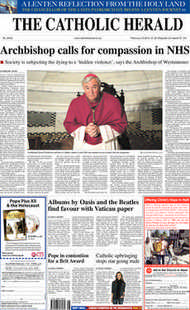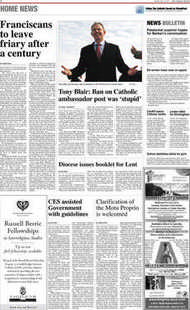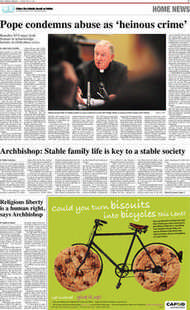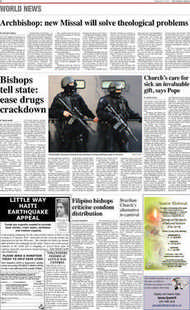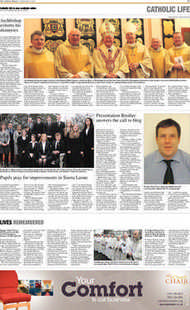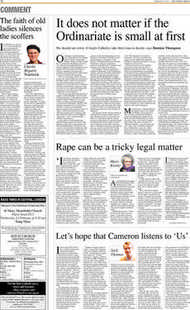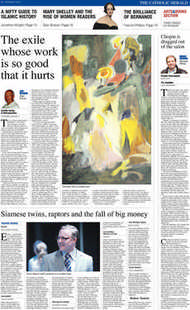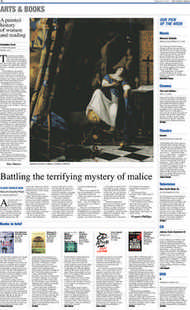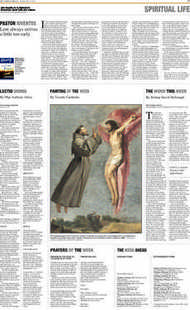Page 2, 19th February 2010
Page 2
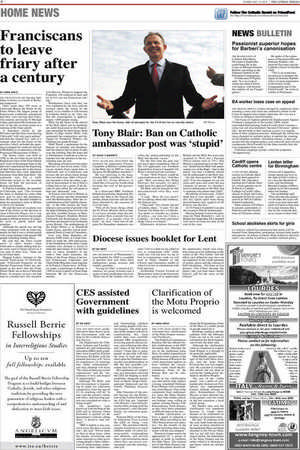
Report an error
Noticed an error on this page?If you've noticed an error in this article please click here to report it.
Tags
Share
Related articles
Franciscans Plan To Open Yorkshire Friary
Order Of Friars Minor: Recent Appointments
Franciscan Friaries To Close Down
Missioners Cross
Franciscans And Douai
Franciscans to leave friary after a century
BY ANNA ARCO
THE FRANCISCANS are leaving their friary in Surrey as a result of declining manpower.
After more than 100 years at Chilworth House the Order of the Friars Minor, the largest group of Franciscans worldwide, announced that they were leaving their friary. The minister provincial, Fr Michael Copps, announced the imminent closure of the old novitiate house at a meeting of the friary parish.
A statement issued by the Province said the friars were leaving Chilworth “with very great sadness” and that the closure was “part of a strategic plan for the future of the province which included the opening of a project for youth at Cold Ash in Berkshire in co-operation with the Franciscan Missionaries of Mary”.
The Surrey friary was built in 1890 as the novitiate house for the English province of the Friars Minor and “most of the present friars in the province experienced the beginning of their Franciscan life in this house and therefore they carry important memories from their time there”, the statement said. For a while Chilworth served as the novitiate house for both the provinces of Britain and Ireland, Fr Patrick Lonsdale, the guardian of Chilworth, said: “The novitiate has been in Ireland for some time now and we have the postulancy here. We haven’t decided whether to keep the postulancy here in Britain or move it to Ireland.” He said that lack of vocations was one of the factors in the decision to close Chilworth House, but it was also a question of not having enough people to fill the positions of authority such as parish priest and guardian.
Although the parish was not big when compared with an inner-city parish, he said it was a vibrant parish with young families with around 200 people attending Sunday Mass.
He said that the friars would move to other houses when Chilworth is closed, adding that friars were used to being moved as it was part of their lives. There are seven friars there.
Maggie Larkin, minister to the secular Franciscans of Chilworth, said: “Chilworth Fraternity of the Secular Franciscan Order are saddened at the news that the Friars Minor Order are to leave Chilworth Friary. At present we have not had time to consider how this situation will affect us. Whatever happens the Fraternity will continue to meet and try to live out our Franciscan calling.” Parishioners have said they are very saddened by the news and are worried about the future of the parish, as to whether it will remain in Catholic hands at all. They say that the congregation is approximately 1,000 people strong.
Plans for the future of the church of the Holy Spirit and its buildings are under discussion as the Franciscans streamline for their future. Built thanks to Mgr Arthur Wells, who sponsored the construction, and designed by Frederick Walters, the buildings are grade-II listed.
Mark Wood, a spokesman for the diocese of Arundel and Brighton, said the diocese had no plans to take over the building after the friars left it. Parishioners would have to be integrated into the parishes in the surrounding area, he said.
Becoming a Franciscan friar takes between six and seven years. Franciscan student friars spent time in Chilworth and in Canterbury and novices did not return home during their novitiate year. After a Franciscan becomes a friar, he enters a period of discernment to see if God is calling him to be a priest. If he decides to seek office, he will spend at least one “diaconate” year.
St Francis sent friars to Britain in the 13th century and they flourished until the Reformation. After the reestablishment of the Catholic hierarchy in the 19th century the friars entered a new period of growth with the help of Belgian friars in Cornwall and they founded friaries in Manchester, Glasgow, Stratford, Bristol, Chilworth and Buckingham. Today the friars are present in seven friaries across Britain. The motherhouse of the Friars Minor is at Woodford Green, Essex, and they run an international Study Centre at Canterbury.
Last year Pope Benedict addressed 4,000 friars at Castel Gandolfo, to mark the 800 anniversary of the foundation of the order. Large numbers also flocked to Assisi to mark the anniversary. It was the first time so many members of the order’s four main branches, the Order of the Friars Minor, Conventual Franciscans, Capuchins and Third Order Regulars came together in St Francis’s home town. St Francis made a pilgrimage to Rome in 1209 to receive approval from Pope Innocent III for the Franciscan statutes.
blog comments powered by Disqus


